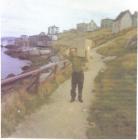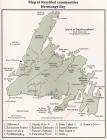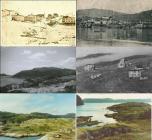1
Norm Courtney takes some belongings down to the Wharf during the move1960-1970
Pushthrough, Newfoundland, Canada

2
The idea behind the efforts of resettlement was to centralize the population to areas of growth and prosperity. Between 1954 and 1975, there were three resettlement initiatives put in place to pressure isolated outport communities to relocate. Over 300 communities and nearly 28,000 people were forced to abandon their towns and move to larger, nearby populations.5
The federal-provincial resettlement programme that was introduced in 1965 was issued by the Department of Fisheries, affecting the small fishing communities such as Grole, Pushthrough, and Round Harbour. Under the conditions that 80-90% of the community's population agreed to relocate to a designated area, each household would be paid a nominal fee for their trouble; a grant of $1000 plus $200 for each dependent, as well as moving expenses and a grant for a building lot. Even with the government grants, many families did not receive much funding for their resettlement, and were forced to make due with as little as a few hundred dollars to purchase new land and pay for moving costs.6
The school in Pushthrough, before and after resettlement.1962, 1989
Pushthrough, Newfoundland, Canada

8
The decision to move was never an easy one and had to be a community-wide decision, usually through town meetings to discuss the conditions. Inevitably, the decision usually came from looking for what would be best for the future of the families and their children in these towns. Many felt that there was nothing left in the communities by that time for people to make a living off of, and they wanted their children to have better opportunities than they had. Often as the town's populations dwindled with families relocating, the remaining families were pressured to make the transition as well. The move would give them better access to luxuries they did not have before such as electricity, running water, and modern appliances, as well as opportunities for better jobs, education and health care. Some felt the move should have taken place sooner, others were reluctant to leave; but in the end 307 towns were deconstructed and abandoned for larger growth areas.9
Rencontre West; before and after resettlement. The houses built there now are used as cabins.7 November 2007
Rencontre West, Newfoundland, Canada



